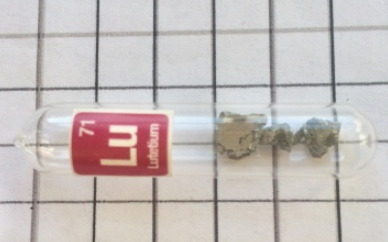Lutetium metal
Lutetium is a silver-white metal, which is the hardest and densest
metal among rare earth elements; it has a melting point of 1663°C, a
boiling point of 3395°C, and a density of 9.8404. Lutetium is relatively
stable in the air; Lutetium oxide is a colorless crystal, which
dissolves in acid to form the corresponding colorless salt. Lutetium is
mainly used for research work, with few other uses. Soft. It is soluble
in dilute acid and can slowly react with water. The salt is colorless
and the oxide is white. Naturally occurring isotopes are: 175Lu and
β-emitter 176Lu with a half-life of 2.1×10^10 years
The rare earth metal of lutetium has a luster between silver and iron.
The content of impurities has a great influence on their properties, so
the physical properties contained in the literature often have obvious
differences. Lanthanum is a superconductor at 6°K. Most rare earth
metals exhibit paramagnetism, and gadolinium has stronger ferromagnetism
than iron at 0°C. Terbium, dysprosium, holmium, erbium, etc. also
exhibit ferromagnetism at low temperatures. The low melting points of
lanthanum and cerium and the high vapor pressures of samarium, europium
and ytterbium show great differences in the physical properties of rare
earth metals. The thermal neutron absorption cross section of samarium,
europium, and gadolinium is larger than that of cadmium and boron, which
are widely used in nuclear reactor control materials. Rare earth metals
have plasticity, with samarium and ytterbium being the best. Except for
ytterbium, the rare earth of yttrium group has higher hardness than that
of cerium group.
.
.
.

Lutetium is a silver-white metal, which is the hardest and densest
metal among rare earth elements; it has a melting point of 1663°C, a
boiling point of 3395°C, and a density of 9.8404. Lutetium is relatively
stable in the air; Lutetium oxide is a colorless crystal, which
dissolves in acid to form the corresponding colorless salt. Lutetium is
mainly used for research work, with few other uses. Soft. It is soluble
in dilute acid and can slowly react with water. The salt is colorless
and the oxide is white. Naturally occurring isotopes are: 175Lu and
β-emitter 176Lu with a half-life of 2.1×10^10 years
The rare earth metal of lutetium has a luster between silver and iron.
The content of impurities has a great influence on their properties, so
the physical properties contained in the literature often have obvious
differences. Lanthanum is a superconductor at 6°K. Most rare earth
metals exhibit paramagnetism, and gadolinium has stronger ferromagnetism
than iron at 0°C. Terbium, dysprosium, holmium, erbium, etc. also
exhibit ferromagnetism at low temperatures. The low melting points of
lanthanum and cerium and the high vapor pressures of samarium, europium
and ytterbium show great differences in the physical properties of rare
earth metals. The thermal neutron absorption cross section of samarium,
europium, and gadolinium is larger than that of cadmium and boron, which
are widely used in nuclear reactor control materials. Rare earth metals
have plasticity, with samarium and ytterbium being the best. Except for
ytterbium, the rare earth of yttrium group has higher hardness than that
of cerium group.
.
.
.

|
|
